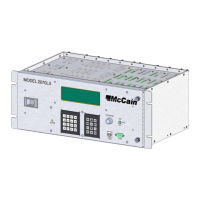14
Each switch provides five Ethernet transceivers; all PHY units support 10BASE-T and 100BASE-TX. In
addition, two of the PHY units support 100BASE-FX (port 4 and port 5).
Each switch is connected to an independent Ethernet port coming from the Engine Board called ENET1
and ENET2.
The Ethernet ports distribution on the Host Board is as follow:
ENET1 Port 0: This port is connected to the Engine Board’s ENET1 port.
ENET1 Port 1: This port is provided through an RJ-45 Ethernet connector on the CPU’s front plate.
ENET1 Port 2: This port is provided through an RJ-45 Ethernet connector on the CPU’s front plate.
ENET1 Port 3: This port is provided through a 12 pins header designated as “CONN1” on the host’s PCB.
ENET1 Port 4: This port is provided through the A5 bus to the serial motherboard.
ENET2 Port 0: This port is connected to the Engine’s board ENET2 port.
ENET2 Port 1: This port is provided through an RJ-45 Ethernet connector on the CPU’s front plate.
ENET2 Port 2: This port is provided through a 12 pins header designated as “CONN2” on the host’s PCB.
ENET2 Port 3: This port is provided through a 12 pins header designated as “CONN3” on the host’s PCB.
ENET2 Port 4: This port is provided through a 12 pins header designated as “CONN4” on the host’s PCB.
All Ethernet ports are magnetically isolated from internal or field connections via isolation transformers
with the proper characteristic impedance.
The Ethernet switches are configured via an EEPROM. Also, they can be configured via a 10-positions
header.
2.4.1.8 USB Hub
The USB Hub expands the USB host port coming from the Engine Board by repeating the bus in order to
increase the number of ports available and thus allow two devices to be connected to the host port.
The USB hub provides one upstream port and four downstream ports. The upstream port connects the
hub directly to the host port on Engine Board and the downstream ports are routed to the USB receptacle
and USB header connectors on the Host board.
The circuitry is comprised of the USB hub controller, a 24MHz oscillator, common mode chokes, dual
supervisory power control switches for all ports and one USB receptacle.
The Host Board provides a USB 2.0 hub controller with integrated upstream and downstream
transceivers, a USB Serial Interface Engine (SIE), USB Hub Control and Repeater logic, and Transaction
Translator (TT) logic.

